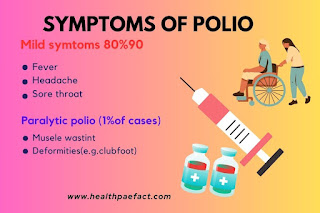Polio
Polio, short for poliomyelitis, is a highly viral disease that mostly affects young children, but understanding its symptoms is critical to early diagnosis and prevention of its spread. Will review the importance of vaccination to protect the public.
Understanding Polio:
Polio is caused by the poliovirus, which is spread mainly through contact with contaminated food, water or infected faeces. The virus attacks the nervous system, resulting in varying degrees of paralysis. Although most people infected with the polio virus experience mild or asymptomatic cases, a small percentage develop severe symptoms, including paralysis, which can be fatal.
Symptoms of Polio:
(1)Flu-like symptoms: In many cases polio begins with flu-like symptoms including fever headache sore throat, fatigue, nausea, and vomiting. These initial symptoms may last for a few days before progressing.
(2)Muscle weakness: One of the main symptoms of polio is muscle weakness or paralysis which usually starts in the legs but can affect other parts of the body as well. Even breathing may be difficult.
(3)Post-polio syndrome: Some people who recover from severe polio can develop polio syndrome years later characterized by new muscle weakness fatigue and painMay be required.
Prevention of Polio:
(1)Vaccination: The most effective way to prevent polio is vaccination. Oral polio vaccine (OPV) and inactivated polio vaccine (IPV) have played an important role in global polio eradication efforts, reducing the incidence of the disease worldwide.
Hygiene and sanitation: Practicing good hygiene such as washing hands with soap and water and ensuring access to clean drinking water and adequate sanitation facilities can help prevent the spread of poliovirus.






0 Comments